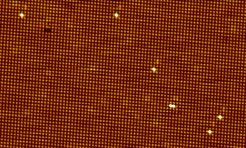From single-ion Kondo effect to Kondo lattice formation
Entanglement is a fundamental concept in strongly correlated electron physics. In heavy fermion metals, the Kondo entanglement between localized f-electrons and itinerant conduction electrons may result in the generation of low-energy scales that can give rise to fascinating phenomena such as quantum criticality and unconventional superconductivity. Such heavy fermion metals are of particular interest as their strong electronic correlations cause a huge increase of the effective mass of the charge carriers. The latter can be considered heavy quasiparticles, comprised of the local f-spin and a ‘screening cloud’ of conduction electrons. These quasiparticles are well described by Landau’s Fermi liquid theory, a theory that has been very successfully applied to explain numerous properties of strongly correlated matter. However, there are also cases that defy such an explanation, typically termed non-Fermi liquid behavior. Materials close to a quantum critical point, at which a second-order zero-temperature phase transition is observed, are prime candidates for such exotic behavior. In this context, YbRh2Si2 has evolved as an archetypal heavy fermion metal to study quantum criticality.
One of the most important techniques that helped shaping our understanding of nonlocal correlations, both magnetic and superconducting, has been scanning tunneling spectroscopy (STS) with its unique ability to give local, microscopic information that directly relates to the one-particle Green’s function. In an earlier work we studied the single-ion Kondo effect, resulting in a dip of the tunneling conductance near zero bias, as well as crystal field excitations. Now, by using STS down to low-temperatures (0.3 K) and in magnetic fields (up to 12 T) we focused on the evolution of the lattice, rather than the single-ion, Kondo effect. We find that the Kondo lattice starts forming already at the single-ion Kondo temperature TK, while the lattice Kondo effect dominates only at much lower temperatures of the order of one-tenths of TK. This allows one to establish a hierarchy of energy scales involved in Kondo lattice formation. The combination of STS with results from bulk measurements, i.e., of magnetotransport and thermopower, indicates that the lattice Kondo correlations have to be sufficiently developed before quantum criticality can set in.
The insights gained in our study will likely be relevant to the non-Fermi liquid phenomena in a broad range of other strongly correlated metals such as the high-Tc cuprate superconductors and the organic charge-transfer salts, which are typically in proximity to Mott insulating states and in which quantum criticality is often observed. The established hierarchy of energy scales may also have an impact on the development of theoretical models to universally describe the evolution of the Kondo interaction from the single-ion level to the formation of a coherent Kondo lattice.
SW / CPfS

Scanning tunneling microscopy image of a Si-terminated surface of YbRh2Si2. The area shown is 30 nm x 18 nm. The very low number of defects evidences an excellent sample quality.
